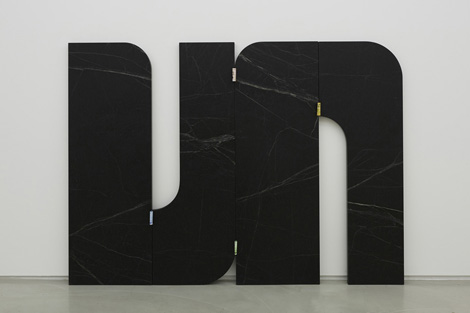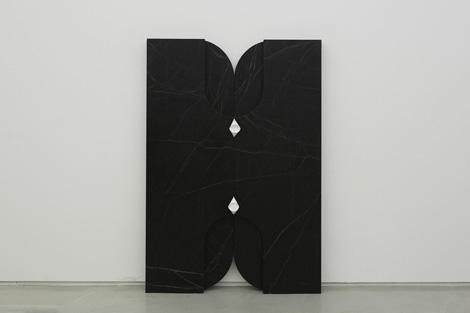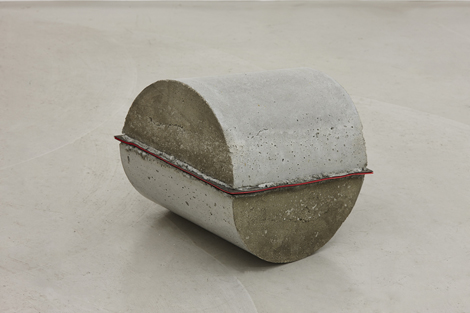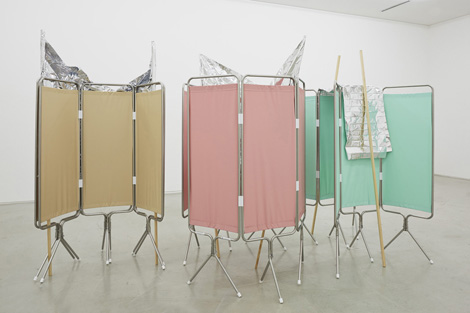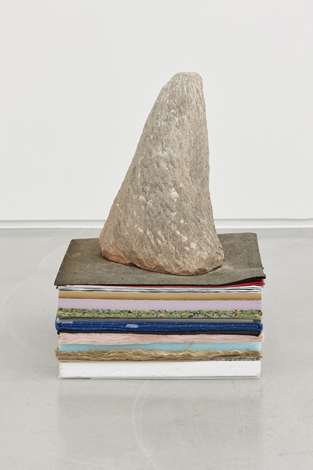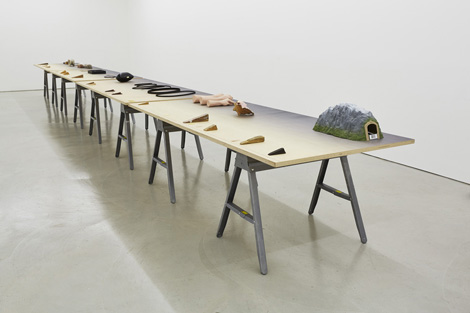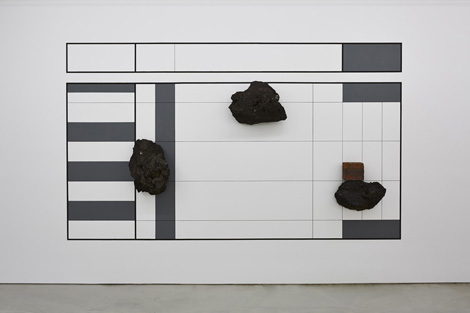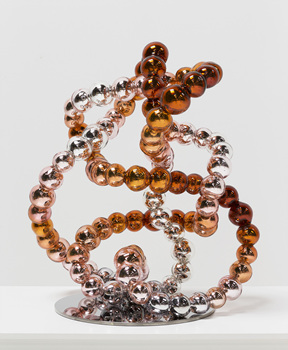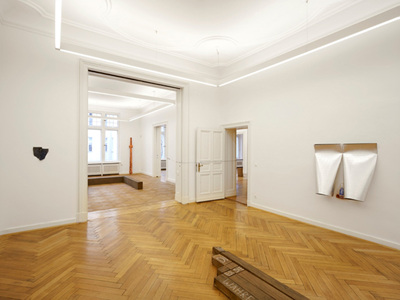 Gabriel Kuri | KUKJE GALLERY
Gabriel Kuri | KUKJE GALLERY

Jun 4, 2015 - Jul 5, 2015
INTRODUCTION
Exhibition Dates: 2015. 6. 4 - 2015. 7. 5
Exhibition Space: Kukje Gallery K1
Opening Hours: Monday - Saturday: 10am-6pm / Sunday, Holiday: 10am-5pm
Website: www.kukjegallery.com
국제갤러리는 국내에서 처음으로 멕시코 출신의 현대미술 작가 가브리엘 쿠리의 개인전을 개최한다. 쿠리는 조각의 형태와 기능에 대한 다양한 시도들을 통해 지적인 엄격함과 비평적인 기품에 바탕을 둔 작품세계를 구축함으로써 국제적 명성을 쌓아왔다. K1 전시관의 1층과 2층에 걸쳐 선보일 작품들은 이번 국제갤러리의 전시를 위해 특별히 제작되었으며, 특히 그가 서울에 머무는 동안 수집한 오브제들이 작품의 일부로서 전시될 예정이다. 그의 작품은 강철과 돌과 같은 전통적인 조각의 재료 외에도 돈, 발견된 오브제, 그리고 소비자라면 누구에게나 친숙한 소비재들을 포함하고 있다. 사회적이고 경제적인 사례들에 대한 자신의 관심을 반영하듯, 작가는 공공장소 및 문화적 교류의 익숙한 관행들에 대한 추론들을 관객들 스스로 문제 삼게 할 만한 복잡한 배치들을 기술적으로 구현해내고 있다.
가브리엘 쿠리의 조각과 설치작품은 익숙한 것과 낯선 것의 어느 중간 지점에 자리 잡고 있다. 작가는 조각의 형식적이고 개념적인 가능성들 못지않게 그것들의 심리적 효과에 관심을 가지며, 그의 작업은 다양한 조합들로부터 도출되는 결과들을 신중하게 실험하는 일종의 연구윤리를 반영하고 있다. 감춰져 있을 뿐 아니라 때로는 승화된 의미를 구현해내는 일상적 재료들에 주목하는 쿠리의 작품들은, 유연한 방식으로 관객들의 예상을 따라 움직이면서 그것을 담아내기도 한다. 이와 같은 방식으로 그는 작품을 통해 동시대 소비문화와 세계화를 예리하게 비평하고 있다. 작가는 자신의 작업의 특성에 대해 다음과 같이 요약한다. “일상적인 것을 재료로 하는 작업은 나로 하여금 예측할 수 없지만 본질적이고, 불완전하지만 물질적으로 충만한 그것들의 존재에 이르기까지 탐색할 수 있게 해준다. 그리고 시간의 충만함을 드러내는 방식으로, 그것을 우회함이 없이, 이 사물들은 아이디어와 가능성들의 의미 있는 형태들을 실제로 떠올린다.” 각각의 작업들은 내밀한 조각 작품으로서 기능하지만, 동시에 쿠리는 작품과 그것이 놓인 장소 사이에서 일어나는, 일종의 3차원적 의미론의 퍼즐을 만들어내는 독특한 역동성에도 관심을 갖는다.
전시장 1층에 설치된 두 개의 연계된 작품들은 작가의 독창성과 형식적 비유에의 관심을 완벽하게 보여준다. 연마된 대리석과 한국 지폐로 만들어진 <Won Won>은 네 개의 매끈하게 절단된 대리석 조각들과 그 틈들에 꽂혀 있는 화폐들로 구성된다. 얼핏 보기에는 무작위로 배치된 듯 보이지만, 각각의 접힌 지폐의 미묘한 색상 차이는 그것들의 면면을 따라 나타나는 높낮이로 인해 일종의 악보를 연상시킨다. 하얀 종이컵들을 대리석의 교차부분에 박아놓은 두 번째 연계 작품 <Stock Stock>과 더불어, 이 두 작품들은 모던한 조각적 요소들과 인간적 거래의 평범한 상징들이 함께 놓여있는 부조화스러우면서도 유머러스한 병치를 보여준다. 이러한 전략이야말로, 전통적 예술 소재들과 일상적 삶의 규정하는 파편들 간의 팽팽한 긴장을 유지하면서, 형태들을 완숙하게 다루는 쿠리의 장인적 면모를 보여주는 것이기도 하다.
이 작품의 옆에는 <Looping trajectory through collapsing mountain 01>이라는 제목의 작품이 있는데, 강철로 제작된 지지대에 얹힌 유색 알루미늄 롤로 이루어져 있다. 이 알루미늄 롤은 보통 시장에서 상품의 진열을 위해 쓰이지만, 여기서는 조절 가능한 철골을 휘감으며 오르내림으로써 비이성적 열정과, 심지어 바로크적 순간이라고 부를 수 있을 어떤 것까지도 환기시키고 있다. 같은 공간에 설치된 이 작품들은 부드러우면서도 단단한 재료와 구조들의 이분법(dichotomy)을 환기시킬 뿐 아니라, 자신의 작업을 구축하는데 있어 종종 균형과 압력의 지점들을 활용하는 작가에게 또 다른 작업의 주제를 제시하고 있다.
또한, K1 전시장의 1층에 설치되는 주요작인 <Privacy Standards>(2015)는 금속으로 제작된 ‘사생활 보호 스크린’으로 이루어져 있다. 이 작품은 병원에서 탈의해본 경험이 있는 사람이라면 누구나 알법한 알루미늄 스크린과 작가의 작품에 자주 등장하는 오브제인 알루미늄 천을 지탱하는 두 개의 막대기가 합쳐진 것이다. 작가는 이렇게 자주 등장하는 조각적 형태를 ‘Quick Standard’라고 부르는데, 이는 정치적 플래카드와 유사성을 암시하는 표현이다. 이렇게 함께 설치된 작품들은 그 안쪽이나 사이로 걷는 관객들로 하여금 폭로와 은폐의 암묵적 긴장감을 조성케 함으로써 하나의 작은 드라마를 만들어낸다.
1층에서 마지막으로 보여지는 <Comprised Vertical Growth>와 <Insulated Horizon Loop>은 경제학적 현실의 불안정함을 다루고 있다. 이 작품들은 시장예측을 하기 위해 경제학자들이 동원하는 불투명한 언어를 유희적으로 비평한다.
전시장의 2층에는 1층과는 상반되는 유기적인 형태의 조형물이 설치되는데, 특별 제작된 네 개의 탁상에는 미묘한 색상과 일정한 간격의 격자가 더해졌다. <Punctuation Matrix>라고 제목이 지어진 이 작품은 마치 실험실 또는 연구실 같은 환경을 연상시키는데, 작가가 여러 나라를 여행하는 동안 신중을 기하여 수집한 물품들이 올려져 있다. 이렇게 전시된 물품들은 작가의 개념적 탐구과정을 떠올리는 동시에 비교적 부드러운 방식으로 오늘날의 미술시장에서 어떤 것이 작품이고 작품이 아닌지에 대한 질문의 장을 연출하고 있다. 작가는 이 작품들이 자신의 “머릿속에서 일어나고 있는” 것을 그대로 보여준다고 말한다.
작가는 탁상들을 둘러싼 벽에 <Probability Chart (K1)>와 <Probability Chart (K2)>를 설치하였는데 그것들은 바로 석고 벽에 박혀 있는 것처럼 보이는 커다란 돌들로 이루어져 있다. 돌이 설치된 자리의 바로 아래에는 연구나 실험적 측량을 연상시키는 그리드 무늬가 그려져 있다. 작가는 돌 위에 옷을 널어놓았는데, 이로써 평범한 중고품 거래장소, 그리고 더 복잡한 어떤 것을 암시하는 듯한 상황을 한번 더 겹쳐놓고 있다. 쿠리에게 있어, 이 설치작품은 분류의 형식적 논조, 그리고 질서의 원칙들이 일상적 환경과 우리가 사물들에 부여하는 가치들을 규정하는 방식에 대한 탐구인 것이다.
국제갤러리는 메인 갤러리의 두 층에 이르는 야심 찬 전시를 통해 오늘날 가장 진취적이고 비중 있는 작가들 중 한 명인 가브리엘 쿠리의 작업을 조명하는 독자적인 기회를 제공한다.
가브리엘 쿠리는 1970년 멕시코시티에서 태어나 멕시코 UNAM 국립 예술 학교에서 시각예술을 수학하였으며 영국의 골드스미스 대학에서 석사학위를 취득하였다. 현 미국 캘리포니아 로스앤젤레스에 거주 및 작업 중이다. 국내에 주요하게 소개된 바 있는 데미안 오르테가, 아브라함 크루지비예게스, 제로니모 로페즈와 함께 동시대의 가장 대표적인 남미 현대미술가인 가브리엘 오로즈코 밑에서 사사 하였다.
주요 개인전 이력으로는 2000년 멕시코시티 루피노타마요 미술관에서 «중요한 순간», 2003년 벨기에 앤트워프 현대 미술관에서의 «정지하기를 정지하는 시작», 2010년 독일 프라이부르크 쿤스트페어라인에서 «점들을 연결하여 포인트 만들기», 2011년 런던 사우스런던 미술관에서의 «가브리엘 쿠리: 긴급 사태 전, 사실 이후», 2012년 노르웨이 베르겐아트홀에서 «가브리엘 쿠리», 2014년 글래스고 커먼길드에서 «가브리엘쿠리: 모든 확률 형태로 해결»과 금년 2015년 콜로라도 아스펜 미술관에서의 «가브리엘 쿠리: 계약상의 사물성에 감사를 전하며»를 포함한다.
그룹전으로는 2003년 제 50회 베니스 비엔날레 Sonsbeek 9 에 참여하였으며, 런던의 서펜타인 갤러리에서 State of Play전에 참여했고 2011년 뉴욕 아모리쇼의 비주얼 아이덴티티를 의뢰 받아 작업하기도 하였다. 주요 소장처로는 파리 퐁피두 센터, 로스앤젤레스 해머 미술관, 시카고 현대 미술관, 샌디에고 현대 미술관, 런던 테이트 모던, 미네아폴리스 워커 아트 센터 등 저명한 기관의 공공 컬렉션들이 있다.
Kukje Gallery is pleased to announce its first exhibition with Gabriel Kuri. Internationally celebrated for his diverse investigations into the form and function of sculpture, Kuri has built a reputation based on intellectual rigor and critical panache. Installed on both floors of K1 gallery, the exhibition will showcase new works made specifically to be shown in Korea and include objects the artist has sourced while in Seoul. Kuri’s work is composed of a broad range of materials including traditional materials such as steel and stone as well as money, found objects, and consumer materials familiar to any shopper. Reflecting the artist’s interest in both social and economic models, he skillfully composes complex arrangements inviting the viewer to question their assumptions about public space and familiar rituals of cultural transaction. This marks the artist’s inaugural exhibition in Korea.
Gabriel Kuri’s sculptures and installations occupy a compelling middle ground both familiar and strange. Interested in the formal and conceptual possibilities of sculpture as well as their psychological impact, his work reflects an ethic of research, where the artist carefully experiments with the implications of different combinations. By framing everyday materials as embodying hidden, sometimes sublimated meaning, Kuri’s work remains flexible, shifting to reflect the preconceptions of the viewer. In this way his work presents an incisive critique of contemporary consumer culture and globalization. According to the artist, “Working with everyday objects allows me to explore the materials to the extent of their being unpredictable yet essential, incomplete yet sufficient materially; and by embodying the richness of time without bypassing it, they truly evoke the significant features of ideas and possibilities.” While each individual work functions as a discrete sculpture, Kuri is equally interested in the dynamic that occurs between his works and their site, thereby creating a kind of three-dimensional semantic puzzle.
Installed on the first floor two related works perfectly illustrate the artist’s ingenuity and engagement with formal tropes. Made from polished marble and Korean paper currency (Won), Won Won consists of four pieces of cut and polished marble between which are stuck denominations of money. Arranged in a seemingly random array, the subtle hues of the folded bills suggest a kind of musical score, rising and falling across its face. Coupled with a second companion work Stock Stock into which white paper cups are stuck in the marble’s intersections, the two pieces provide a jarring and humorous juxtaposition of modernist sculptural elements with everyday symbols of human transaction. This strategy reflects Kuri’s mastery of forms, holding a poised tension between traditional art materials and the detritus that defines everyday life.
Adjacent to this work is another piece titled Looping Trajectory through Collapsing Mountain 01 (2015) which consists of colored aluminum rolls supported on steel display stands. Designed to display goods at a market, the aluminum rolls rise and fall around this adjustable armature, evoking both irrational exuberance and, perhaps, a baroque moment. Installed together, these works suggest the dichotomy of soft and hard materials and structures, suggesting another leitmotif of the artist, who often uses balance and pressure points to construct his work.
Also in the first floor gallery will be a major work Privacy Standards (2015) consisting of metal privacy screens. Familiar to anyone who has had to disrobe in a doctor’s office, these screens are coupled with a familiar Kuri object—two sticks supporting an aluminum blanket. The artist refers to this recurring sculptural form as a “Quick Standard,” alluding to its resembling a political placard. Together, the installation forms a micro drama, evoking intimate tensions of revelation and concealment that are completed by the viewer who walks in and amongst this installation.
The final two works in this gallery further point to the vicissitudes of economics. Titled Compromised Vertical Growth and Insulated Horizon Loop, these pieces play with the opaque language used by economists to describe market forecasts.
Installed on the second floor, the artist has installed an organic sculpture on four aligned custom designed worktables each of which have been painted with a subtle gradation and overlaid with gridded measuring lines. Titled Punctuation Matrix, the work resembles a laboratory or research environment. Arranged on the tables the artist has carefully placed objects collected both locally and on his international travels. In this way, they evoke the conceptual investigations of the artist and set the stage for a less formal query about what is and what is not art in today’s marketplace. They are in the artist’s words, an illustration of what is “going on in my head.”
On the walls surrounding the tables Kuri has installed two works titled Probability Chart (K1) and Probability Chart (K2) (2015) that consist of a series of large rocks that appear to be embedded into the plaster. Painted directly onto the walls beneath the rocks is a large grid pattern, again alluding to research and empirical measurement. Hanging casually atop the rocks the artist has included some clothing, further conflating an environment that suggests both a casual swap meet and something more complex. For Kuri, this installation explores the formal cadences of taxonomy and the way ordering principles determine both everyday environments and the values we assign objects.
A far-reaching and ambitious exhibition, the works on the two floors of the K1 gallery provide an unprecedented opportunity to reflect on one of today’s most challenging and important artists.
Gabriel Kuri was born in Mexico City in 1970 and studied Visual Art at National School of Arts, U.N.A.M. in Mexico. He received M.A. from Goldsmiths College in UK in 1995. Key solo exhibitions include Momento de Importancia, Museo Rufino Tamayo, Mexico City, Mexico (2000); start to stop stopping, Museum of Contemporary Art, Antwerp, Belgium (2003); Join the Dots and Make a Point, Kunstverein Freiburg, Freiburg, Germany (2010); Gabriel Kuri: Before Contingency After the Fact, South London Gallery, London, UK (2011); Gabriel Kuri, Bergen Kunsthall, Bergen, Norway (2012); Gabriel Kuri: All Probability Resolves Into Form, The Common Guild, Glasgow, UK (2014); and Gabriel Kuri: with personal thanks to their contractual thingness, Aspen Art Museum, Aspen, Colorado (2015). He showed his work at the 50th Venice Biennale in 2003. Also, he was commissioned to create the visual identity for the 2011 Armory Show in New York City. His works are included as public collections of prominent institutions including Centre Pompidou in Paris, The Hammer Museum in Los Angeles, Museum of Contemporary Art in Chicago, Museum of Contemporary Art in San Diego, Tate Modern in London, and Walker Art Center in Minneapolis. Gabriel Kuri currently lives and works in Los Angeles.
Gabriel Kuri is known for incorporating a range of detritus and found objects into his practice, combining man-made and organic materials to hint at a borderless global economy of objects. His interest in ubiquitous objects partly stems from the fact that, as signs of transactions, they acknowledge our participation in consumer society. Like other contemporary artists working with everyday materials, Kuri is generally indebted to the work of Marcel Duchamp and the legacy of “Readymades” that stems from the early 20th century. Building on this tradition Kuri has expanded the filed even further, all the while maintaining an incisive critical voice.
WORKS
|
Looping Trajectory through Collapsible Mountain 01 - 01 |
Won Won |
|
|
Looping Trajectory through Collapsible Mountain 01 - 02 |
Stock Stock |
|
|
Insulated Horizon Loop |
Privacy Standards |
|
|
Compromised Vertical Growth |
Punctuation Matrix |
|
|
Probability Chart K1 |
Probability Chart K2 |
|
INSTALLATIONS
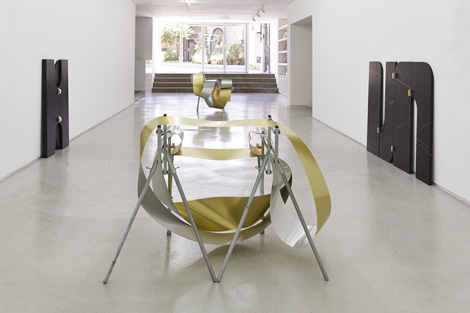
|
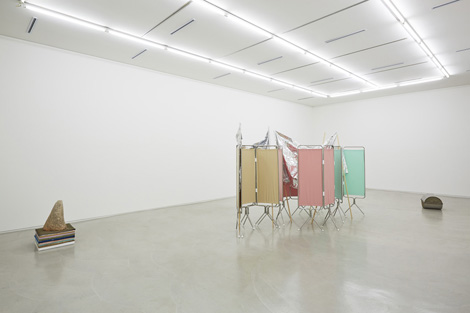
|
|
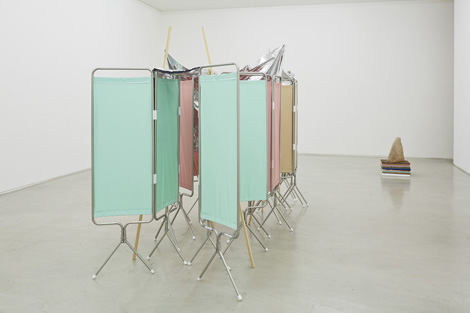
|
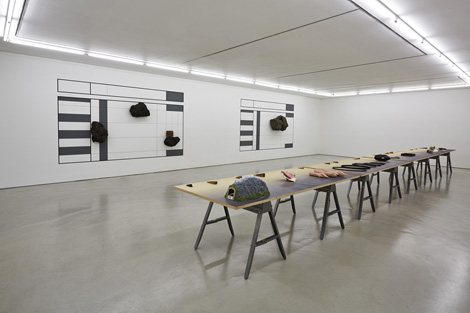
|
|

|
PUBLICATIONS
| Gabriel Kuri |
MEDIA COVERAGE
일간지
월간지
주간지/웹

